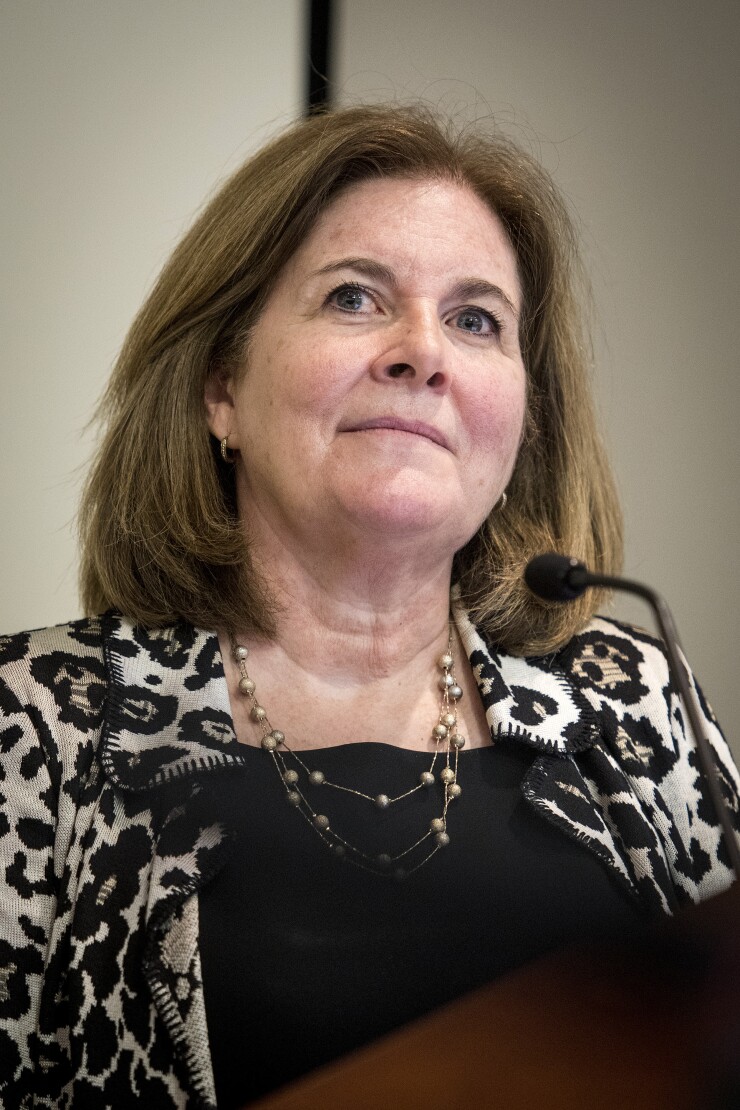Maintaining that gradual rate hikes remain the best course for the economy, Federal Reserve Bank of Kansas City President Esther George said Wednesday the Federal Open Market Committee “is, by historical standards, meeting the dual mandate.”
“Taking the recent performance of the labor market and inflation together, I would argue that the FOMC is, by historical standards, meeting the dual mandate,” George told the Central Exchange in Kansas City, Mo., according to prepared text of a speech released by the Fed. “Yet our policy interest rate remains below FOMC participants’ estimate of its longer-run level.”

The rate is in a range between 1% and 1.25%, while the FOMC’s median projection of the longer-run funds rate is 2.8%.
Although she backed the setting of a 2% inflation target, “in hindsight I think it has proven to be far more challenging than expected both as a communications mechanism and a policy guide. Too much focus is placed on achieving this specific numerical target when, in fact, inflation is likely to fluctuate around that target with deviations that occasionally might persist.”
Instead, she prefers using the definition that has guided the Fed previously “An inflation rate that does not materially affect the decisions of business or households is an inflation rate that is consistent with price stability.”
While 2% remains an appropriate goal, George said, “I think it makes sense to evaluate deviations from that objective in a broader context.”
Although inflation remains below 2%, the 4.2% unemployment rate is below the FOMC’s median projection of 4.6% unemployment. With expectations for better than trend GDP growth likely to lower unemployment rates further, George said, “the recent, and persistent, softness of inflation relative to 2 percent has not prevented the economy from achieving and, arguably, overshooting maximum employment.”
In the last quarter of 2016, the PCE inflation rate less food and energy was 1.9% for the year, she noted, “It’s only been since February that we have seen a weakening in this measure of core inflation.”
As to why inflation remains soft while the economy is healthy, George said, “My best guess is that it is a combination of idiosyncratic shocks combined with a number of longer-run changes that are holding down inflation.”
While a stronger dollar and a drop in oil prices in 2014 suppressed inflation, “these forces should now be abating, [yet] several structural factors — such as global competition, an aging population, technological change and disruptive forces in the retail sector — may persist,” she said.
“These developments, along with the persistence of inflation below target, may also have contributed to inflation expectations settling at a level somewhat less than 2% percent,” George said. “If so, monetary policy may be confronted with a difficult dilemma. Should policy normalization proceed on a gradual path to avoid overheating the economy? Or would it be more prudent to wait until inflation reaches 2 percent before taking further steps to tighten policy?”
Recently, inflation has not responded to labor market slack. “In my view, because of the weakness of the relationship between inflation and slack, it would take a considerable overheating of the economy to move inflation more quickly up to 2 percent,” she continued. “Such overheating would, in the meantime, foster a misallocation of resources and risk financial instability as asset prices continue to climb.”
A significant drop in unemployment could push inflation “considerably above” 2% and prompt an abrupt increase in rates, she suggested. Because of lags in monetary policy, “by the time we see inflation actually moving up to 2 percent, it may be too late to prevent an undesirable overshooting,” which could cause a recession.
George pointed to the early 2000s, when inflation was thought to be low and the FOMC held rates a 1%. Inflation levels were “subsequently revised up, and by 2005 inflation had risen above 2 percent.”
The short-term borrowing inspired by low rates fed “a buildup of financial imbalances and a bubble in the housing market,” George noted. “These excesses ended with a severe financial crisis and the Great Recession.”
However, she stressed, it is wise “for the FOMC to move cautiously and continue to monitor inflation developments to better understand the causes and consequences of low inflation.”
In her opinion, “we should continue to make gradual adjustments to normalize policy rates. Waiting for solid evidence that inflation will reach 2 percent before taking further steps to remove accommodation carries risks of overheating the economy, fostering financial instability, and perhaps putting in motion an undesirable increase in inflation.”





